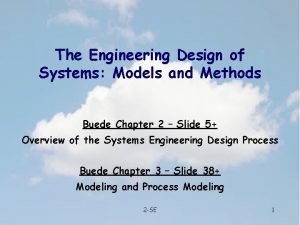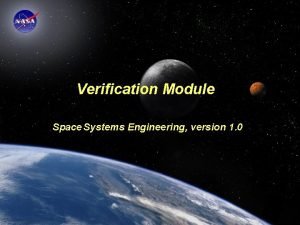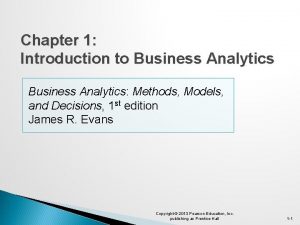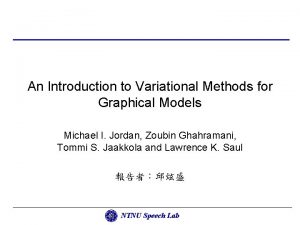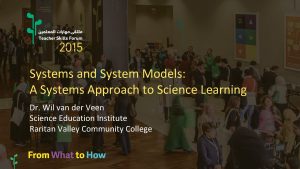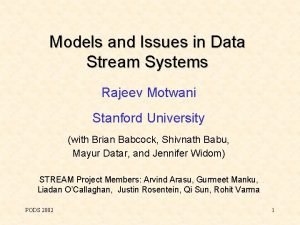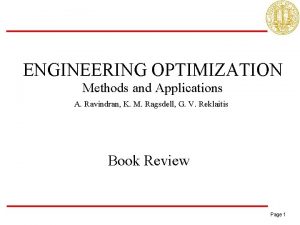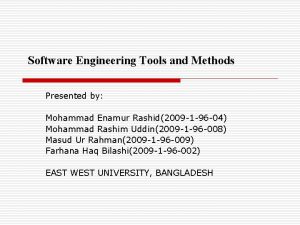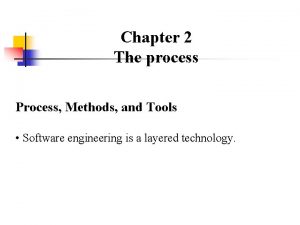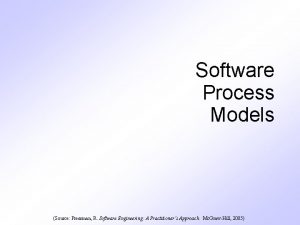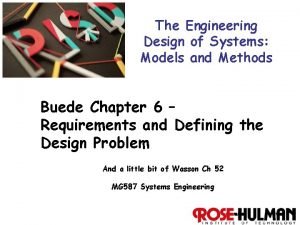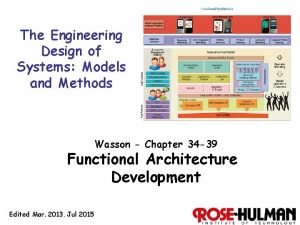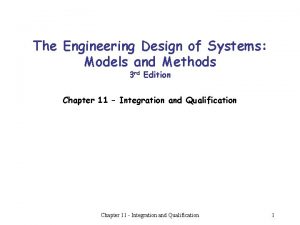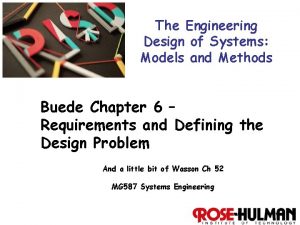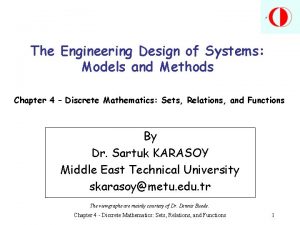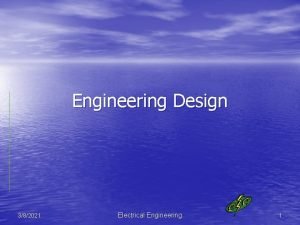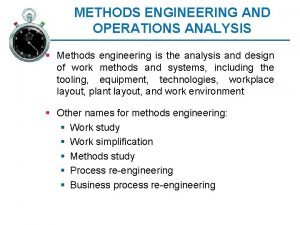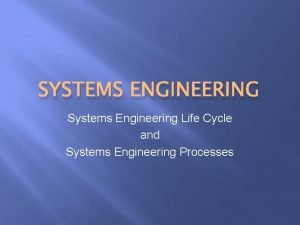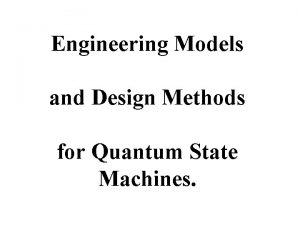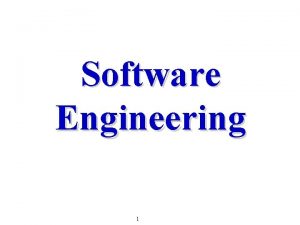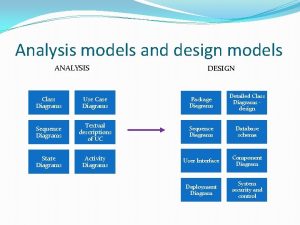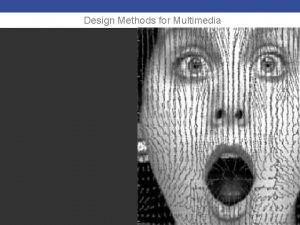The Engineering Design of Systems Models and Methods


















- Slides: 18

The Engineering Design of Systems: Models and Methods 3 rd Edition Chapter 2 - Overview of the Systems Engineering Design Process 1

Key Terms • • • System: set of components (subsystems, segments) acting together to achieve a set of common objectives via the accomplishment of a set of tasks. System Task or Function: set of functions that must be performed to achieve a specific objective. Human-designed System: · specially defined set of segments (hardware, software, physical entities, humans, facilities) acting as planned · via a set of interfaces, which are designed to connect the components, · to achieve a common mission or fundamental objective (i. e. , a set of specially defined objectives), · subject to a set of constraints, · through the accomplishment of a predetermined set of functions. Chapter 2 - Overview of the Systems Engineering Design Process 2

External Systems & Context Chapter 2 - Overview of the Systems Engineering Design Process 3

Functions of the Design Process Chapter 2 - Overview of the Systems Engineering Design Process 4

Functions of the System-Level Design Problem Chapter 2 - Overview of the Systems Engineering Design Process 5

Functions of the Integration & Qualification Process Design Function Major Inputs Major Outputs Conduct early validation Stakeholders’ inputs Operational concept Originating requirements Derived requirements Validated operational concept Conduct integration and verification testing Configuration items (CIs) Components Derived requirements Verification testing document Verified components and system Conduct system validation testing Verified system Originating requirements Stakeholders’ inputs Validation testing document Validated system Conduct system acceptance testing Validated system Acceptance test plan Stakeholders’ inputs Acceptance testing document Accepted system Chapter 2 - Overview of the Systems Engineering Design Process 6

Key Concepts • Operational Concept: vision, mission requirements, & scenarios • External Systems Diagram: meta-system • Objectives Hierarchy: cost, schedule & performance measures of effectiveness • Requirements – – Input/output Technology & System-wide Trade-off System Qualification Chapter 2 - Overview of the Systems Engineering Design Process 7

Key Concepts (Cont. ) • Function: transformation by system of inputs into outputs • Items: inputs & outputs of a system • Components: subset of a system • Interfaces: connection resource between systems and components • Verification: determination that physical design meets requirements • Validation: determination that right system has been developed • Acceptance: determination that stakeholders accept system Chapter 2 - Overview of the Systems Engineering Design Process 8

An Entity Relationship Diagram of the Key Concepts Chapter 2 - Overview of the Systems Engineering Design Process 9

Elevator Scenarios 1. Passengers (including mobility, visually, and hearing challenged) request up service, receive feedback that their request was accepted, receive input that the elevator car is approaching and then that an entry opportunity is available, enter the elevator car, request a floor, receive feedback that their request was accepted, receive feedback that the door is closing, receive feedback about the floors at which the elevator is stopping, receive feedback that an exit opportunity is available at the desired floor, and exit the elevator with no physical impediments. 2. Passenger enters the elevator car, as described in scenario 1, but finds an emergency situation before an exit opportunity is presented, and notifies the police or health authorities using communication equipment that is part of the elevator. Elevator maintenance personnel create an exit opportunity. 3. A maintenance person needs to repair an individual elevator car; the maintenance person places the elevator system in “partial maintenance” mode so that the other cars can continue to pick up passengers while the car(s) in question is (are) being diagnosed, repaired, and tested. After completion, the maintenance person places the elevator system in “full operation” mode. Chapter 2 - Overview of the Systems Engineering Design Process 10

Elevator External Systems Diagram (IDEF 0) Chapter 2 - Overview of the Systems Engineering Design Process 11

Elevator Objectives Hierarchy Chapter 2 - Overview of the Systems Engineering Design Process 12

Requirements Hierarchy • Input/Output Requirements • • Input Output External Interface Functional • System-wide & Technology Requirements • • Technology Suitability Cost Schedule • Trade-off Requirements • Cost • Performance • Cost-Performance • Qualification Requirements • • Observance Verification Plan Validation Plan Acceptance Plan Chapter 2 - Overview of the Systems Engineering Design Process 13

Elevator Requirements (Sample) 4. 3 Originating requirements 4. 3. 5 Operational phase requirements 4. 3. 5. 1 Input/output requirements 4. 3. 5. 1. 1 Input requirements 4. 3. 5. 1. 1. 1 Emergency support inputs 4. 3. 5. 1. 1 The system shall support manual overrides 4. 3. 5. 1. 1. 1. 2 The elevator system shall allow passengers with a designated pass key to assume complete control of an elevator car 4. 3. 5. 1. 2 Output requirements 4. 3. 5. 1. 2. 1 Passenger environment outputs 4. 3. 5. 1. 2. 1. 1 The elevator car shall have adequate illumination. 4. 3. 5. 1. 4 Functional requirements 4. 3. 5. 1. 4. 1 The elevator shall accept passenger requests and provide feedback. 4. 3. 5. 1. 4. 2 The elevator shall move passengers between floors safely and comfortably. 4. 3. 5. 1. 4. 3 The system shall control elevator cars efficiently. 4. 3. 5. 1. 4. 4 The system shall enable effective maintenance and servicing. 4. 3. 5. 2 System-wide and technology requirements 4. 3. 5. 2. 1 The system MTBF shall be greater than 1 year. The design goal is 1. 5 years. Failure is defined to be a complete inability to carry passengers. 4. 3. 5. 2. 2 The system MTTR shall be less than 8 hours. The design goal is 4 hours. Repair means the system is returned to full operating capacity. Chapter 2 - Overview of the Systems Engineering Design Process 14

Elevator System Function Chapter 2 - Overview of the Systems Engineering Design Process 15

Elevator Functional Decomposition Chapter 2 - Overview of the Systems Engineering Design Process 16

Elevator Physical Architecture Chapter 2 - Overview of the Systems Engineering Design Process 17

Comparison of TTDSE & Sys. ML Chapter 2 - Overview of the Systems Engineering Design Process 18
 The engineering design of systems: models and methods
The engineering design of systems: models and methods Dicapine
Dicapine Elegant systems
Elegant systems Systems engineering verification methods
Systems engineering verification methods Difference between models and semi modals
Difference between models and semi modals Business analytics methods models and decisions
Business analytics methods models and decisions Business analytics methods models and decisions
Business analytics methods models and decisions Business analytics methods models and decisions
Business analytics methods models and decisions Qm for windows linear programming
Qm for windows linear programming Engineering systems design 2
Engineering systems design 2 An introduction to variational methods for graphical models
An introduction to variational methods for graphical models Indirect methods of contoring uses how many methods
Indirect methods of contoring uses how many methods Systems and system models
Systems and system models Models and issues in data stream systems
Models and issues in data stream systems Engineering optimization methods and applications
Engineering optimization methods and applications Software engineering tools and methods
Software engineering tools and methods Process methods and tools in software engineering
Process methods and tools in software engineering Software and systems integration facility
Software and systems integration facility Software process models
Software process models
